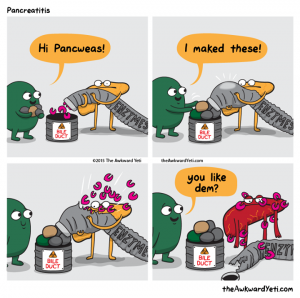Diagnosis of pancreatitis can be made based on clinical findings on a physical exam; identification of associated disorders, like gallstones or alcohol use; laboratory findings; and imaging techniques, such as CT scan, MRI, and ultrasonography (McCance & Huether, 2014).
Acute Pancreatitis
Acute pancreatitis is difficult to diagnose due to several other disorders presenting with similar laboratory and clinical symptoms. The primary diagnostic marker for acute pancreatitis is serum lipase. Serum lipase levels increase within 4 to 8 hours of clinical symptom onset and decrease within 8 to 14 days. Serum amylase levels are elevated as well, but are not an indicator of severity or specificity of the disease. Serum trypsin levels are very specific in indicating pancreatitis, but the test is not widely available. Severity can be predicted and measured by C-reactive protein, procalcitonin, blood urea nitrogen (BUN), and Bedside Index of Severity in Acute Pancreatitis (McCance & Huether, 2014). Table 3 below shows the criteria for BISAP.
Although there is no specific treatment for pancreatitis, the goal is to stop autodigestion and prevent further systemic complications. In the first 24 hours, it is important to have hemodynamic monitoring and parenteral fluids to restore blood volume and prevent hypotension and shock. Narcotics may be used to relieve pain. Meperidine hydrochloride (Demerol) is used instead in cases of chronic alcohol use affecting the sphincter of Oddi, which controls flow of bile from the common bile duct to the duodenum and prevents reflux of duodenal contents. Demerol is used because it causes less spasm of the sphincter. Nasogastric suctioning may not be needed for mild pancreatitis, but may help relieve pain and prevent paralytic ileus (loss of parastaltic motor activity in the intestine) in nauseated and/or vomiting individuals (McCance & Huether, 2014).
Enteral nutrition via a jejunal tube feeding may be helpful in cases of severe acute pancreatitis. Jejunal tube feedings may decrease pancreatic enzyme secretion, prevent gut bacterial overgrowth, and maintain gut barrier function. Drugs, like H2 receptor antagonists, that decrease gastric acid production can decrease stimulation of the pancreas by secretin (regulates secretions in the stomach, live, and pancreas). Necrotizing pancreatitis requires surgical resection, and possibly antibiotics to control infection (McCance & Huether, 2014).
Chronic Pancreatitis
Chronic pancreatitis is due to repeated exacerbations of acute pancreatitis leading to chronic changes. Treatment includes preventing disease progression though lifestyle modifications to stop smoking and alcohol use. Analgesics, endoscopic therapy, nerve block, and surgical drainage of cysts or partial resection of the pancreas can be used for pain management. Corticosteroids can be used to treat autoimmune chronic pancreatitis (McCance & Huether, 2014).

